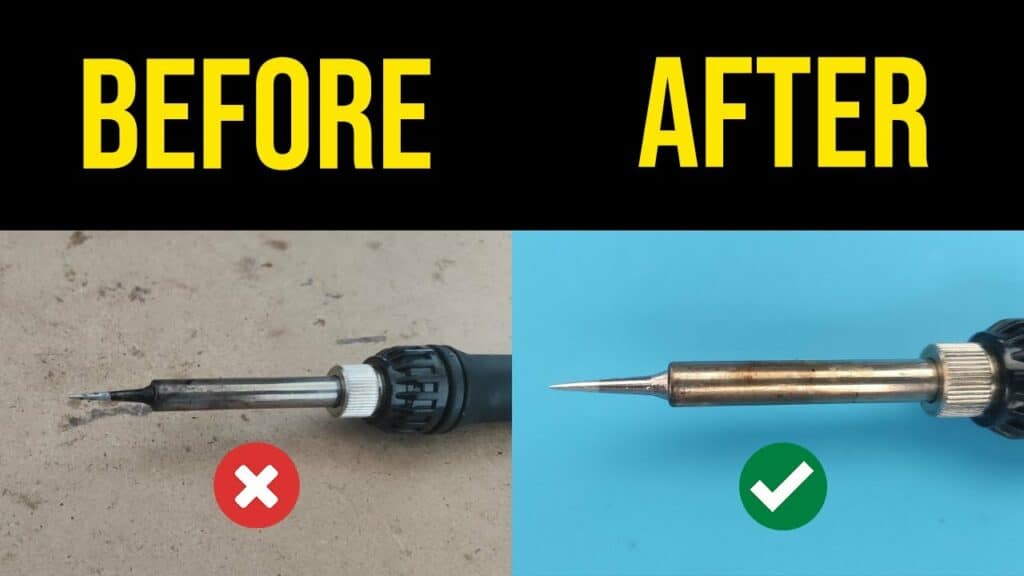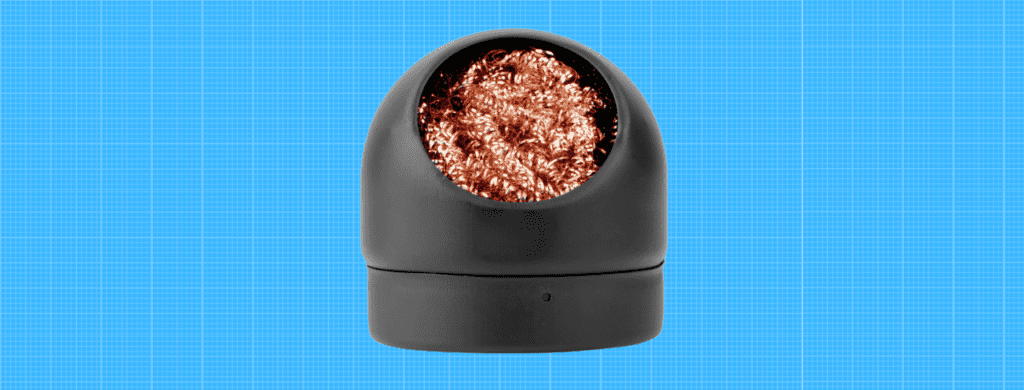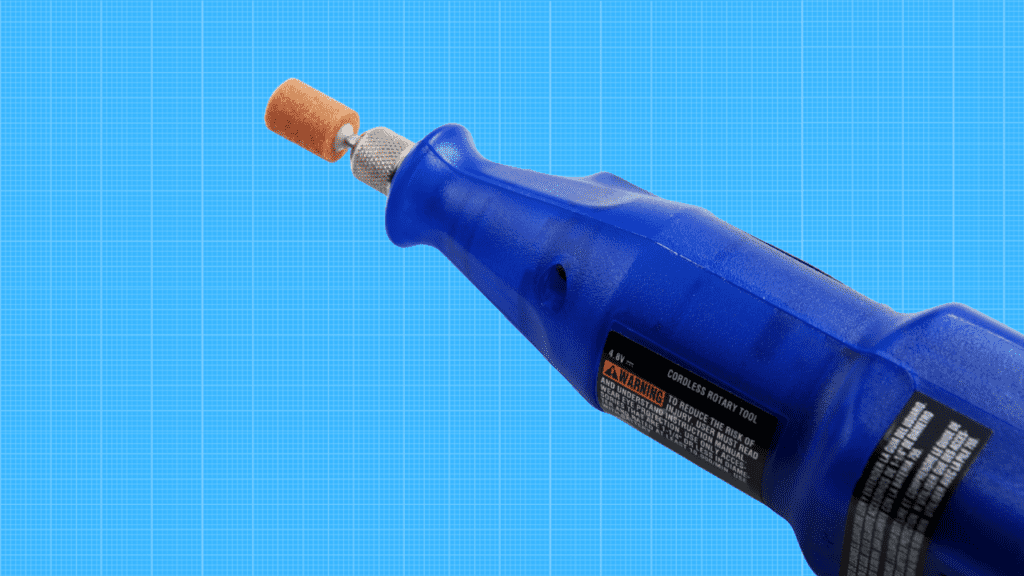How to clean soldering iron – Ultimate Guide
There are nothing worse than a soldering iron that won’t solder.
Today, we will discuss how to clean soldering iron and some tips for keeping it in good condition.
You will see three easy ways to clean a soldering iron tip, and make it look like you just bought it.

Signs For Cleaning
- Not Work Properly
When a soldering iron doesn’t work correctly, it’s often because the tip isn’t clean. If the tip is dirty, the solder won’t stick to it, and the joint will be weak.
- Takes a Long Time to Warm Up
If you notice that your soldering iron takes a long time to warm up, it means that its oxidized part does not allow it to transfer heat. In this case, the corroded part acts as an insulator.
It’s like you’re trying to go through a doorway for pets.
Here you can find out how long it takes for the soldering iron to heat up.
- Stinks When Turning On
When the soldering iron starts working, it immediately starts heating the tip. If it then starts to stink, heat is burning the dirty part at the top. This means that oxidation has begun to form at the tip.

What is Causing the Problem?
There are plenty of reasons to create oxidation. Using not a quality soldering wire or contact paste that contains various metals that stick to the top of the soldering iron leads to such a condition.
Using a soldering iron at high temperatures damages the tip.
Also, the soldering iron corrodes over time because it has not been cleaned for a long time.
Why do they need maintenance?
The main reason soldering irons need maintenance is that they can get dirty. If the iron isn’t cleaned regularly, the dirt and grime will start to build up, and it will eventually affect the quality of your solder joints.
Another reason you should maintain your soldering iron is that it can affect the tool’s lifespan. It can erode if you don’t clean and tin the soldering iron regularly. This will shorten the life of the soldering iron and could eventually lead to it breaking down.
Cleaning Methods
The combination of sponge and metal wool effectively cleans the tip of the soldering iron. Also, using flux and rotary tool can help restore the old shiny look.
Wet Sponge
A wet sponge is the cheapest and worst way. Before and after working with a soldering iron, you need to go through the wet sponge a couple of times.
This will remove the rough layers of dirt, but oxidation will remain. A wet sponge can help in the beginning, but over time it is not a good option.
The sponge is a good free option.

Steel Wool
Steel wool is a handy tool to have around when it comes to cleaning solder iron tips. To clean the tip, simply take a piece of steel wool and rub it against the tip until the solder is gone.
Make sure to remove any debris that may have been left behind before putting the soldering iron away.

Flux
Take a flux or contact paste and dip a hot soldering iron in them. That will remove both dirt and a little oxidized part. This method is taught in school.
This is good but again, not enough to remove the corroded part.
Because there are minor metals in the flux and contact paste that will stick to your soldering iron again. When the soldering iron cools down, the oxidized part will appear again through some time.
Always use a high-quality flux for your tip.

Rotary Tool
Definitely, the best way to restore the look-alike is when you just bought a soldering iron. Is to use a rotary cleaning tool.
Here’s the secret. We will first remove the layer of dirt and oxidation with some of these extensions.
Before cleaning and polishing, the soldering iron must be cool and dry to successfully remove all the dirt and oxidize parts.
First, gently pass over each part of the soldering iron tip. You usually need a minute or two to remove in detail. Do not press, but lightly press the top next to the top.
Now that you have removed the dirt and oxidized metal stuck to your soldering iron use one of these polishing attachments. This will bring that soldering iron to its original appearance. Spin each part in detail. You won’t need more than a minute of work.
The Rotary tool is inexpensive, and it does such a good job. My honest recommendation is that even though you are a beginner or advanced, take this tool because it will make your job easier when it comes time to maintain soldering iron.

Video
In this video we explain how to clean the top and give it back its old shiny look.
How to Prevent Oxidation?
Tinning Your Tips
Tinning the soldering iron tip means coating it with a thin solder layer. This will help the solder flow more efficiently, and it will also help protect the tip from oxidation. To tin the soldering iron tip, simply apply a small amount of solder to the tip and wipe it off with a clean cloth.
The solder will help keep the tip clean, and it will also make it easier to apply the solder to the joint. Be sure to tin the soldering iron tip before each use.
When you’re finished using the soldering iron, be sure to tin the tip again.
Keeping your tips tinned will extend the life of the tip twice.
Tips for keeping soldering iron tip in good condition
- Regular Cleaning
Regular cleaning is the primary way to save your soldering iron. After working with the soldering iron, please take a few minutes to clean it.
- Storing Tips
Store in a dry place is an essential thing. The tip of the soldering iron is metal like any other. That is why it needs to be in a dry place so that it does not rust.
If the soldering iron is in a basement or a damp room, place it in a box to prevent direct contact with wet air. Also, covering with a cloth can help.
- Quality solder
A quality coil and flux will slow down the corrosion of your soldering iron. The cheap coil is made of low-quality material that rather grabs for your soldering iron than a component.
- Optimal temperature
The optimal temperature for a soldering iron is about 600°- 650°F (316°- 343°C). Suppose the temperature of the soldering iron is too low. In that case, the solder will not flow properly, and the connection will be weak. If the temperature is too high, the solder may melt prematurely or damage the joined components.
Keeping the optimum temperature will help make the soldering iron tip last longer.
What Happens If You Don’t Maintain Your Soldering Iron?
If you don’t maintain your soldering iron, it could eventually stop working. The main problems you will experience are corrosion, rusting, and a build-up of dirt and grime.
The Benefits of Properly Maintaining Your Soldering Iron
There are several benefits to properly maintaining your soldering iron. These include:
- A longer lifespan for the soldering iron
- A better quality solder joint
- Less chance of damage to the soldering iron or the components being soldered together
Common Problems That Occur When a Soldering Iron is Not Properly Maintained
Several common problems could occur if you do not maintain your soldering iron. These include:
- The soldering iron will not heat up properly
- The solder will not flow correctly
- The solder joint will be weak and could break easily
- The soldering iron could start to corrode or rust
- There could be a build-up of dirt and grime on the soldering iron tip and other parts of the tool. This will make it difficult to solder correctly and could damage the soldering iron.
Time to Change the Tip
Soldering iron tips are prone to rapid corrosion and cannot last forever. Regular cleaning can extend the shelf life. But when you notice that small holes start to form at the top, it is time for a replacement.
Small holes are formed after corrosion. They are like a metal disease. They destroy metal at the micro-level and thus create holes of irregular shape. After a couple of months, if you clean the soldering tool, the tip starts to erode and makes holes in itself.
Then it’s too late to start cleaning, but you can try. Damage over time will allow less and less heat transfer, and the soldering tool will become unusable.
That’s why it’s good to have spare tips for your soldering tool. The important thing is to know that not every soldering iron has extra tips. Usually, cheaper soldering irons do not have spare tips.
Adjustable temperature soldering irons have shown better endurance resistance than soldering irons without temperature control.
Conclusion
Today, all tips are made of metal. Metal is a material that is prone to rapid rusting. That is why it needs to be maintained often.
Do not allow your soldering iron to remain dirty after work. If you have the opportunity, get spare tips so that you don’t end up in a situation where you need a soldering iron, and it won’t work.
And don’t forget to tin the tip after finishing your job.
